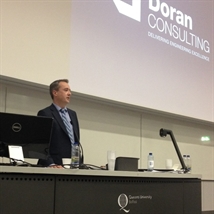Extending the Belfast Waterfront
06 October 2016

Doran Consulting’s Dr Paul Keown presented his paper "Belfast's Changing Waterfront - Extending the Waterfront Hall" to engineering colleagues at the recent IStructE NI Evening Meeting.
Doran Consulting were commissioned by McLaughlin & Harvey to carry out civil and structural design of the new extension to the Belfast Waterfront. The new extension wraps around the existing building, connecting to the existing facilities at multiple levels. The site beside the river Lagan proved challenging, being extremely restricted in terms of access and by surrounding structures and its proximity to the river. Ground conditions were extremely challenging, due to the presence of numerous below ground obstacles passing through the building footprint. These included historic quay structures, and a major storm sewer.
These constraints made the positioning of foundation piles for the extension extremely difficult. The quay walls and storm drain alignment were key drivers to the foundation solution, requiring piles to be located away from desired column locations. Extended pile caps and bridging slabs were used widely to bridge over the old quay structures and existing sewer line, carrying loads from the superstructure above. Extensive use was also made of mini piling techniques in areas of the site where access was not possible for larger piling rigs due to proximity to the existing building or low headroom.
The super structure for the extension used over 1400 tonnes of structural steelwork. Large spans were required to create the large flexible open plan conference areas. This included the use of heavy fabricated plate girders, deep cellform beams and heavy trusses, combine with complex column arrangements throughout the structure. Complex secondary steelwork was needed to support the cladding system for the extension, and also internally to support the flexible rigging system needed in the public spaces.
This project was Belfast City’s Council’s first use of BIM on a major project. The use of BIM allowed the design team to integrate a digital survey of the existing building into the 3D models for the extension. This was vital in fitting the new structure around the existing building and avoiding site clashes. All main designers produced information in a 3D environment using Autodesk REVIT. The combined models allowed for coordination between disciplines, identification of problems, and resolution before reaching site.
The design team were also able to export 3D information directly to subcontractors, such as the steelwork fabricators. The exchange of models with them produced more accurate quotes and fabrication models, which could be double checked by the design team.
For more information on the extension please visit the Extension to the Belfast Waterfront project page.